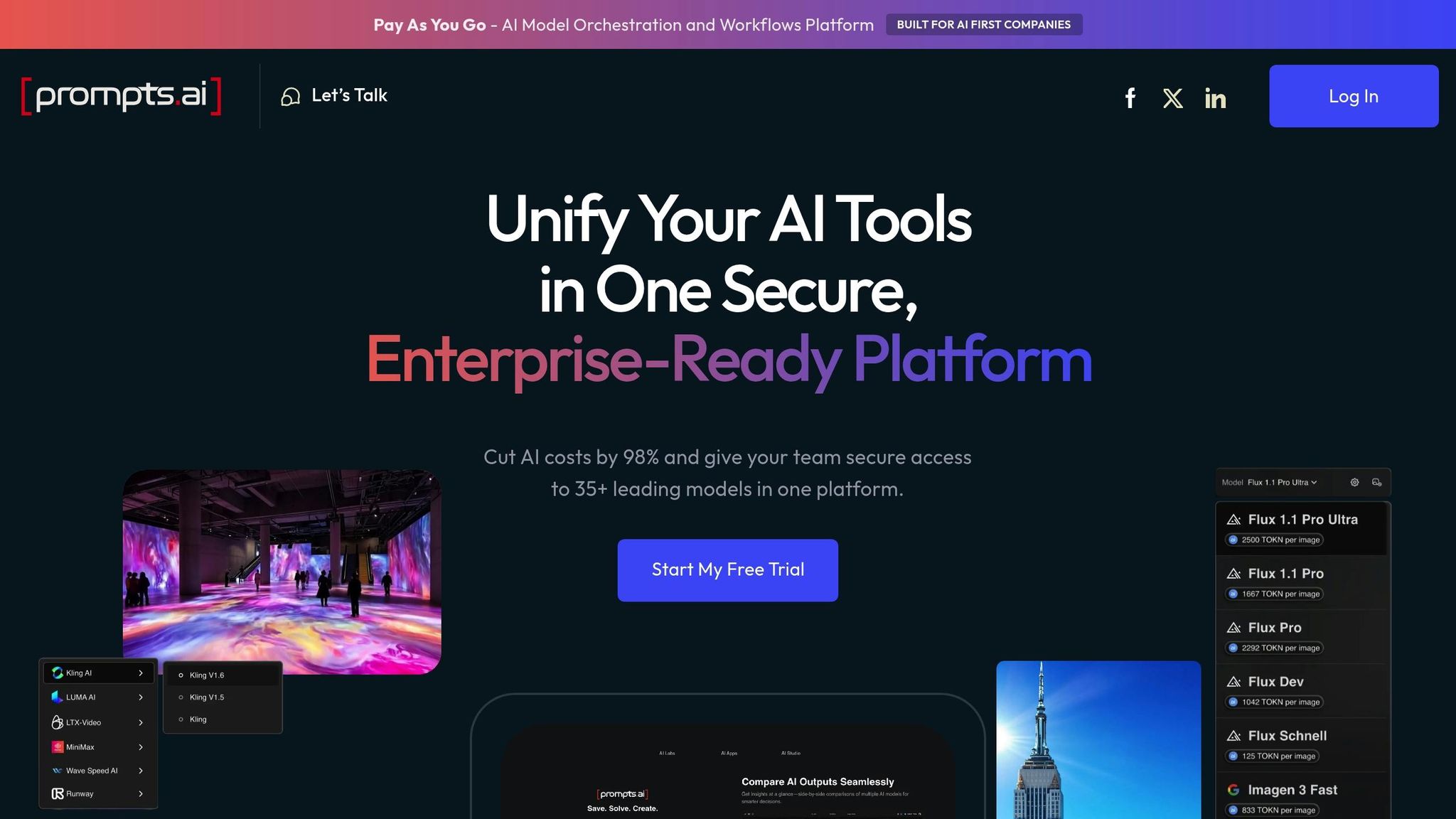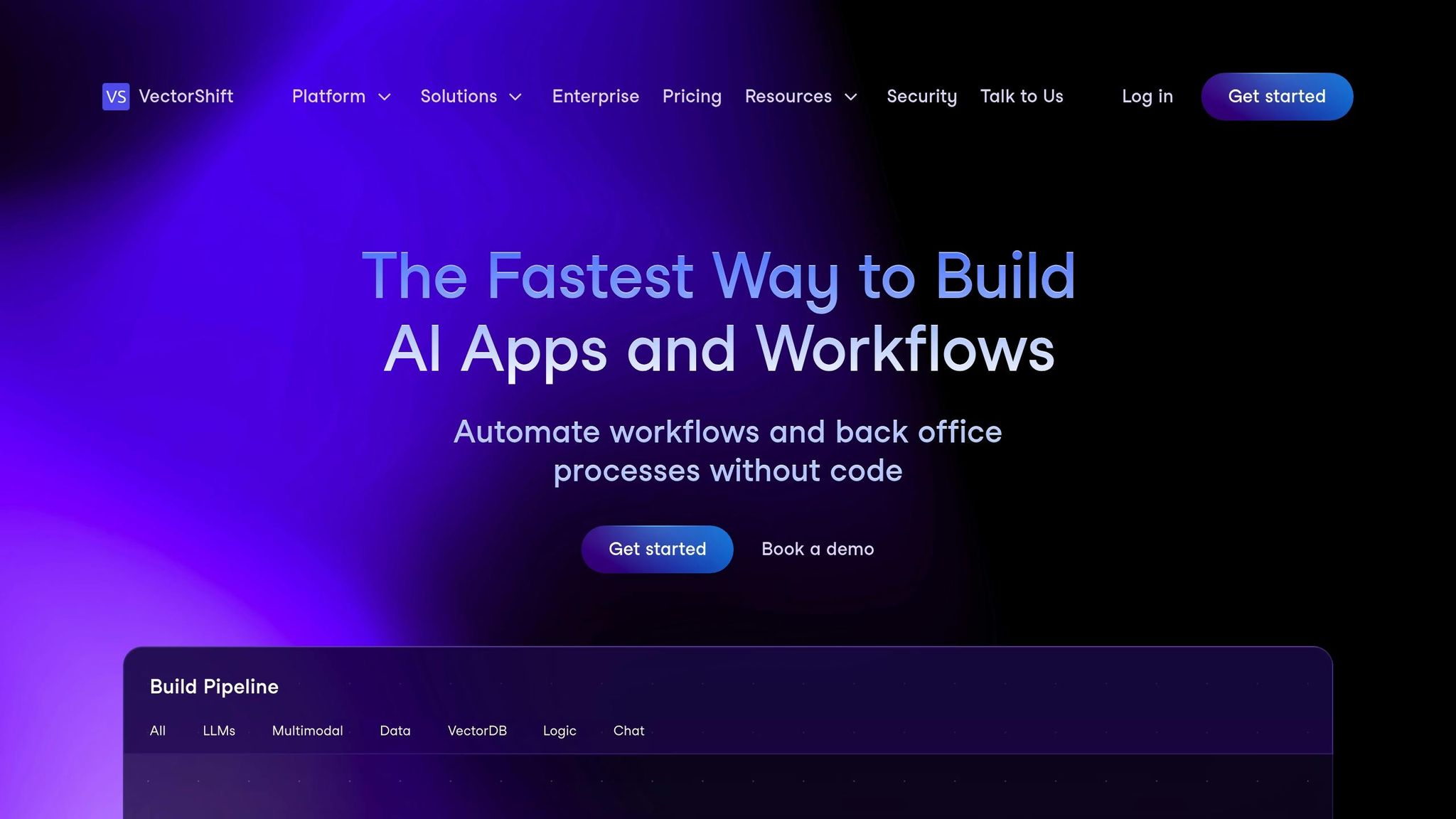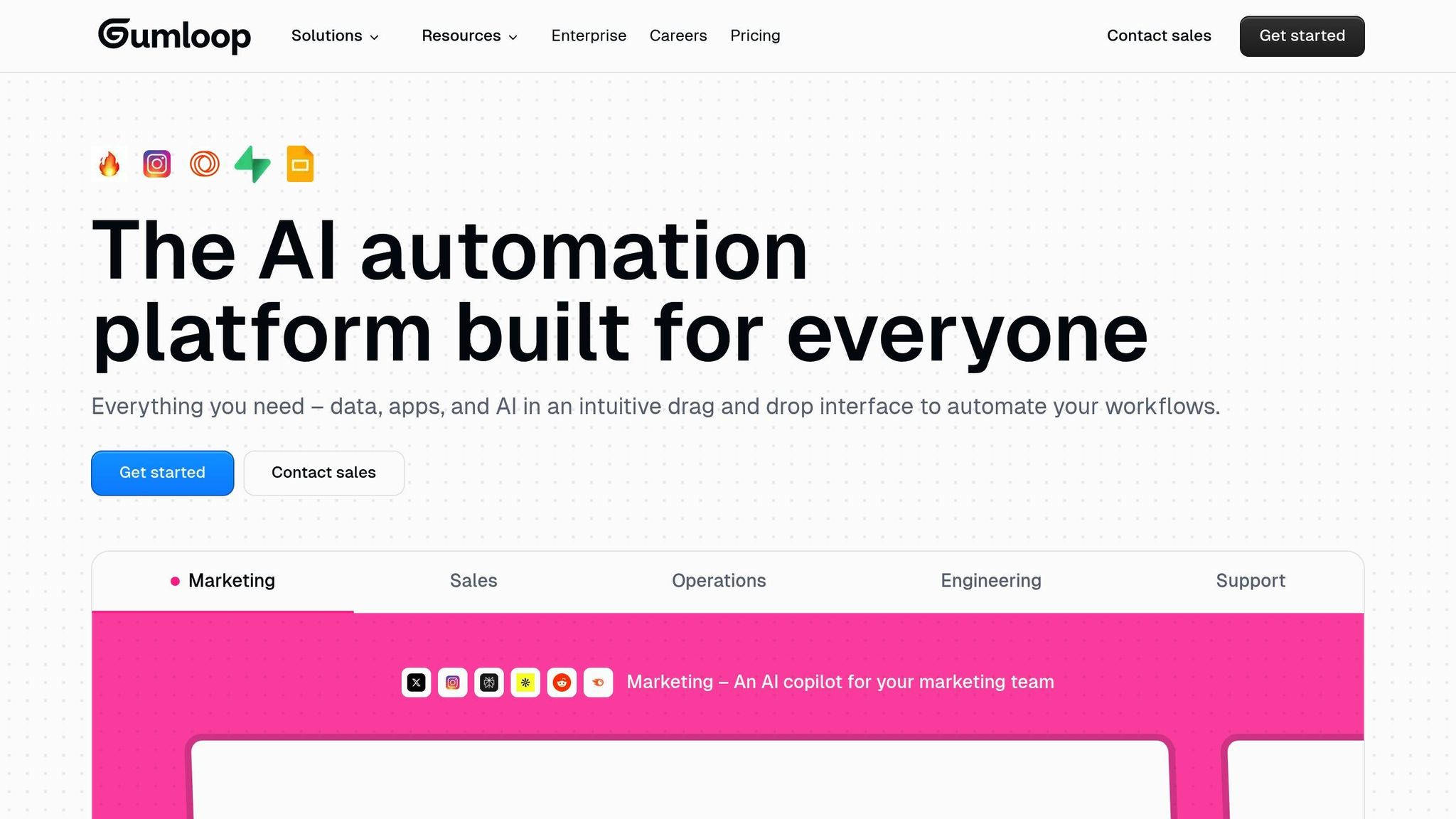
AI tools are transforming how businesses handle repetitive tasks, saving time and reducing costs. Whether you're managing invoices, scheduling, or customer support, these platforms streamline operations and boost efficiency. Here’s what you need to know:
Quick Takeaway: Prompts.ai stands out with 35+ AI models, SOC 2 compliance, and a pay-as-you-go system that can cut AI costs by 98%. Other tools, like n8n and Lindy.ai, offer flexible integrations and user-friendly designs.
Explore your options to find the best fit for your business needs.
Choosing the right AI workflow automation tool is more than just a technical decision - it’s a strategic one that can directly influence your business’s efficiency and growth. A misstep here could lead to wasted resources, security risks, and integration headaches that negate the very purpose of automation. To make an informed choice, focus on these key factors: integration, security, pricing, scalability, user experience, support, and analytics.
Integration Capabilities
The tool you select should effortlessly integrate with your existing software ecosystem. Seamless connectivity ensures smooth operations without the need for costly custom development or middleware. Look for platforms that natively support your current business tools to avoid delays and inflated IT costs during deployment.
Compliance and Security Standards
Security is non-negotiable, especially for businesses in the US. Opt for platforms that meet strict standards like SOC 2 Type II certification, ensuring robust protocols for handling sensitive data. If your operations involve international customers, GDPR compliance is equally critical. Features such as encryption, role-based access, and audit trails are essential to meet both regulatory and internal security requirements.
Transparent Pricing
Unpredictable costs can derail your budget, so prioritize tools with clear pricing structures in US dollars. The best platforms offer straightforward per-user or per-automation pricing without hidden charges for API calls, data storage, or essential integrations. Avoid tools with complex or opaque pricing models that could lead to unexpected expenses.
Scalability for Growing Teams
Your automation tool should grow with your business. Whether you’re a small team or a large enterprise, the platform should accommodate your needs without compromising performance. For smaller teams, simplicity and functionality are key, while larger organizations will benefit from advanced features like custom branding, robust user management, and dedicated support. Ensure the platform can handle increased automation volume without forcing costly plan upgrades.
User-Friendly Design
Adoption hinges on usability. A complicated interface can discourage your team, leading them back to manual processes. Look for tools with intuitive features like drag-and-drop workflow builders, pre-built templates, and clear documentation. These elements reduce the learning curve and help your team get up and running quickly.
Reliable Customer Support
When workflows fail, fast and effective support is crucial. US-based support teams familiar with local business practices and time zones can resolve issues more efficiently than offshore alternatives. Prioritize platforms offering multiple support options, such as live chat, phone assistance, and detailed knowledge bases with video tutorials.
Performance Monitoring and Analytics
To truly understand the value of automation, you need tools that provide actionable insights. Look for platforms with detailed dashboards that track metrics like time saved, error rates, and workflow performance. These analytics not only demonstrate ROI to stakeholders but also highlight areas for further improvement.

prompts.ai is a specialized AI-native platform designed to streamline workflow automation by combining over 35 top-tier language models, such as GPT-5, Claude, LLaMA, and Gemini, into a single, secure interface. It’s tailored for businesses aiming to simplify and automate intricate, decision-intensive processes.
prompts.ai integrates effortlessly with widely-used US business tools, including Slack, Salesforce, Google Workspace, and Microsoft 365, enabling smooth data flow across your existing software ecosystem. For instance, a mid-sized marketing agency in the US utilized prompts.ai to automate its client onboarding process. By connecting Salesforce for CRM data, Google Calendar for scheduling, and Slack for team notifications, the agency reduced onboarding time by 40% and improved data accuracy.
With prompts.ai, businesses can synchronize data, trigger actions, and automate complex workflows across their software stack, cutting down on manual tasks and enhancing efficiency.
The platform prioritizes security at every level. It employs end-to-end encryption, detailed user permissions, and comprehensive audit logging to safeguard sensitive data. prompts.ai supports compliance with key standards such as SOC 2 and HIPAA. The company began its SOC 2 Type 2 audit process on June 19, 2025, and uses Vanta for continuous control monitoring. Users can access real-time updates on their security status - including policy progress and compliance metrics - through the Trust Center at trust.prompts.ai.
To further protect data, prompts.ai offers role-based access controls and US-based data residency options, ensuring compliance with local privacy laws. Detailed audit trails help businesses track data access, meeting documentation requirements for regulated industries.
prompts.ai stands out with its straightforward, predictable pricing in US dollars. It offers tiered plans tailored to different needs, from small teams to large enterprises. Each plan clearly outlines included features, usage limits, and potential overage costs, making it easy for businesses to estimate their automation expenses.
The platform uses a Pay-As-You-Go TOKN credit system, aligning costs with actual usage. This approach has the potential to reduce AI-related expenses by up to 98% compared to managing multiple separate tools. Businesses can also take advantage of volume discounts and custom pricing for enterprise needs, ensuring cost-efficiency as they scale. Whether automating basic workflows or managing complex, multi-department processes, prompts.ai adapts without sacrificing performance.
prompts.ai makes sophisticated AI automation accessible to everyone, regardless of technical expertise. Its drag-and-drop interface and pre-built workflow templates allow non-technical users to design, implement, and adjust automated workflows with ease. Features like visual logic builders, natural language prompts, and guided setup wizards simplify the process, enabling teams to get started quickly.
Common applications include automating lead qualification, processing invoices, onboarding new employees, managing customer support tickets, and running marketing campaigns. By empowering more team members to participate in workflow design, prompts.ai accelerates adoption and expands automation across the organization. Additionally, its active community of prompt engineers shares ready-made workflows and practical tips to help users maximize the platform’s potential.

Lindy.ai is a platform designed to help businesses create AI agents using simple natural language commands. These AI agents can take on a variety of tasks across multiple applications, making it easier to automate routine processes without needing advanced technical knowledge.
Lindy.ai connects with thousands of apps, allowing AI agents to seamlessly integrate into your existing software ecosystem. The platform supports linking multiple accounts from the same provider, which is especially useful for organizations managing several instances of the same tool. For example, businesses can use Lindy.ai to streamline communication and lead qualification through Slack, manage meeting schedules with calendars, or build knowledge repositories using tools like Google Drive and Notion.
Lindy.ai also simplifies email management by identifying critical messages, drafting follow-ups, and organizing inboxes. Additionally, its integration with connected knowledge bases enhances customer service operations, enabling efficient handling of support calls and ticket resolutions.
"Connect your apps: Thousands of integrations available."
This extensive connectivity is paired with an intuitive design that prioritizes ease of use.
Lindy.ai takes its integration capabilities a step further by making workflow creation straightforward and accessible. Its prompt-based agent creation system is designed for non-technical users, allowing them to describe tasks, connect apps, and set instructions - all without writing a single line of code. This streamlined, three-step process enables teams to quickly deploy automation solutions by simply explaining their needs in natural language.
"Ask Lindy what to do and watch it build your Agent in minutes."
The platform also allows users to customize agent responses, set triggers, and define workflow logic through conversational commands. This makes automation easy to implement across departments, regardless of technical expertise, empowering teams to optimize their operations efficiently.

Relevance AI takes a fresh approach to workflow automation by prioritizing agent-focused design over traditional trigger-and-action systems. This platform enables businesses to create custom AI agents capable of managing intricate, multi-step processes. This user-centric approach opens the door to adaptable and personalized automation.
Relevance AI simplifies the creation of advanced automation through its no-code/low-code framework. With a natural language interface, even non-technical users can effortlessly build AI agents. The process is straightforward: users name their agents, provide basic instructions in plain language, and choose from a library of pre-built tools like Google Search or Slack. By simply describing the desired task, the platform automatically generates the agent. Additionally, these agents can be connected to sub-agents for more complex workflows.
The platform includes a library of pre-built tools designed to integrate seamlessly with popular US business applications. For example, Google Search can provide real-time data, while Slack facilitates team communication. While the open-ended agent-building feature offers a high degree of customization, it may require a bit more effort to master.

VectorShift stands out by seamlessly connecting various systems, emphasizing interoperability and simplifying business operations. Unlike solutions that lock you into a single vendor's ecosystem, VectorShift ensures smooth integration with the wide array of applications that businesses in the United States rely on daily. Its user-friendly interface further enhances efficiency, making automation across platforms straightforward and effective.
One of VectorShift's key strengths is its ability to integrate with major business platforms in real time. For instance, it connects directly with popular CRM systems like Salesforce and HubSpot, enabling automated updates to customer records and ensuring consistent data across sales pipelines. It also works with Slack to trigger automated actions, such as sending a Slack message when an email is received. Beyond CRMs and communication tools, VectorShift integrates with productivity platforms like Google Drive, OneDrive, Notion, and Airtable, ensuring workflows are always powered by up-to-date information. Additionally, its custom API integration allows businesses to link proprietary systems or specialized software directly into their AI workflows - eliminating the need for additional middleware.
VectorShift goes a step further by making workflow automation accessible to everyone. Its no-code interface allows users to visually design AI-powered pipelines that connect various tools, making it easy for non-technical users to create sophisticated workflows. For those with technical expertise, the platform also supports advanced customization. VectorShift’s workflow builder combines data from multiple sources with AI processing to trigger actions across platforms. For example, it can pull data from a CRM, analyze it using AI, update a project management tool, and send notifications through Slack - all in one seamless operation.

Gumloop stands out as a powerful tool designed specifically for developers, offering an extensible and scalable architecture that’s perfect for handling complex workflows. With pricing starting at $97 per month, it provides a clear entry point for organizations looking to automate basic processes and gradually expand as their needs grow.
The platform’s capabilities have earned it notable recognition in the industry. CIO.com lists Gumloop among the "20 AI workflow tools for adding intelligence to business processes", and Whalesync highlights it as one of the "Best AI Workflow Automation Tools". Whalesync praises the platform’s flexibility, stating:
"Ultimately, Gumloop is one of the most interesting tools I've seen in this space as they're making the platform extensible and scalable enough to handle almost anything."
Such endorsements underscore Gumloop’s ability to address enterprise-level automation challenges, offering the technical sophistication and adaptability required to meet diverse operational demands.

n8n takes an open-source approach to workflow automation, giving businesses full control over their automation processes. Unlike cloud-only platforms, n8n can be deployed on-premises or within a preferred cloud environment, making it ideal for organizations with strict data governance needs or those looking to avoid being tied to a single vendor. This flexibility allows for a tailored automation experience that meets specific business requirements.
n8n offers an easy-to-use visual workflow editor where users can design automations by connecting nodes in a flowchart-like interface. Each node represents a particular action or service, making it simple for teams to build workflows without technical expertise. For developers or advanced users, n8n also supports custom JavaScript code, enabling greater functionality beyond the standard tools.
The platform is equipped to handle complex logic with features like conditional branching, loops, and data transformations - all without requiring heavy coding. It automatically transfers data between nodes, simplifying the creation of intricate workflows that would otherwise demand significant development time.
n8n boasts an extensive library of integrations, connecting effortlessly with widely used US business applications. From Salesforce and HubSpot to Slack, Microsoft 365, and Google Workspace, n8n supports a wide range of tools essential to American enterprises. This ensures smooth operations across diverse business environments.
With its webhook capabilities, n8n enables real-time automation triggers from any system that supports HTTP requests. This makes it possible to integrate custom or legacy software that lacks dedicated connectors, ensuring comprehensive workflow coverage across an organization’s entire tech stack.
n8n’s deployment flexibility also extends to security-conscious organizations, offering self-hosted options that keep sensitive data within the company’s infrastructure. The platform supports enterprise-grade authentication methods like LDAP, SAML, and OAuth, seamlessly integrating with existing identity management systems.
For industries with strict compliance standards, n8n provides audit logging and version control to track every workflow execution, modification, and access event. This feature is crucial for meeting regulatory requirements in sectors like healthcare, finance, and government contracting, where detailed records are often mandatory.
n8n’s open-source model ensures predictable costs, allowing businesses to start with the free community edition and scale up without worrying about per-execution fees. For organizations that prefer self-hosting, this approach also eliminates the risk of rising cloud expenses.
For enterprises needing advanced features like enhanced user management or priority support, n8n offers commercial licenses with fixed monthly rates. This pricing structure makes it easier for companies to plan their budgets, avoiding unexpected cost spikes during busy periods and ensuring efficient, scalable automation for businesses of all sizes.

Make, previously known as Integromat, stands out among integration tools by prioritizing security alongside usability. Designed with U.S. businesses in mind, it ensures compliance with key regulations, offering built-in GDPR and SOC 2 Type II compliance. Data is protected through encryption both during transit and at rest, and it supports single sign-on (SSO) for added convenience. For organizations with more complex security requirements, the Enterprise plan provides advanced controls and round-the-clock support.
The table below provides a clear snapshot of how various AI workflow automation tools stack up against each other. It focuses on key features to help you identify the right fit for your needs.
| Tool | Interoperability | Security & Compliance | Cost Transparency | Scalability | US Compliance Focus | No-Code/Low-Code |
|---|---|---|---|---|---|---|
| prompts.ai | 35+ AI models unified | SOC 2 Type II, HIPAA, GDPR compliant | Pay-as-you-go TOKN credits | Enterprise-ready scaling | Strong US compliance focus | Visual workflow builder |
| Lindy.ai | 3,000+ integrations | Enterprise security standards | Usage-based pricing | Team to enterprise plans | Standard data protection | Drag-and-drop interface |
| Relevance AI | API-first architecture | Enterprise-grade security | Transparent usage metrics | Auto-scaling infrastructure | Cloud-based flexibility | Visual chain builder |
| VectorShift | Multi-model support | Standard encryption | Transparent pricing tiers | Flexible deployment | General data protection | No-code pipeline creation |
| Gumloop | Popular app connections | Basic security measures | Subscription-based | Small to medium teams | Standard practices | Simple visual editor |
| n8n | 400+ node integrations | Self-hosted options | Open-source + cloud plans | Highly customizable | Data residency control | Node-based workflows |
| Make | 1,000+ app connectors | GDPR, SOC 2 Type II | Operation-based pricing | Enterprise controls | EU and US compliance | Visual scenario builder |
Security and Compliance
When it comes to security, prompts.ai stands out with its SOC 2 Type II, HIPAA, and GDPR compliance, providing robust safeguards for sensitive data. Its focus on meeting US regulatory standards makes it a strong choice for organizations prioritizing compliance.
Cost Transparency
Cost structures vary widely across tools. prompts.ai uses a pay-as-you-go TOKN credit system, which eliminates recurring fees and can reduce AI costs by as much as 98% compared to managing multiple standalone tools. This model is particularly appealing for businesses with fluctuating AI demands.
Scalability and Ease of Use
For enterprises, tools like prompts.ai and Make provide advanced scaling options and governance features, making them ideal for larger operations. On the other hand, platforms like Gumloop cater to smaller teams with simpler automation needs and basic scaling capabilities.
No-Code/Low-Code Features
All the tools offer no-code functionality, but their approaches differ. Tools like n8n provide flexibility for users who are comfortable with deeper customization, while others, such as Gumloop, focus on simplicity with user-friendly visual editors. Selecting the right platform depends on your team's technical expertise and the complexity of your workflows.
This comparison highlights the unique strengths of each platform, helping you weigh your options based on security, cost, scalability, and ease of use.
AI workflow automation tools are reshaping how businesses in the US operate, offering streamlined processes, lower costs, and a sharper competitive edge.
Platforms like prompts.ai stand out by cutting AI expenses by as much as 98% through a unified system that simplifies operations. The added time savings directly contribute to a stronger return on investment (ROI).
While cost savings are a major benefit, securing data remains a top priority. Tools like prompts.ai emphasize strong compliance measures, ensuring your operations stay secure and meet necessary regulations.
These solutions cater to businesses of all sizes, from startups to large enterprises, scaling effortlessly to match growth without requiring heavy development efforts or extensive training.
When considering these tools, think about your organization's unique requirements - budget, technical capabilities, integration needs, and compliance standards. Pay attention to how well each platform integrates with your current systems to maximize efficiency. Use these insights to align the tool’s strengths, such as integration, security, and scalability, with your specific goals.
Start by identifying your workflow pain points and use that understanding to guide your choice. The comparison table provided earlier can help you match your needs with the right features.
Taking steps toward AI automation today ensures your business stays ahead in a competitive landscape. Explore the tools that best fit your objectives - your future productivity and profitability will reflect the value of this decision.
Prompts.ai places a strong emphasis on data security and compliance, adhering to established frameworks like SOC 2 and GDPR. This commitment includes employing rigorous security protocols, conducting frequent audits, and enforcing strict access controls to safeguard sensitive data.
The platform is built to align with regulatory requirements, ensuring that data storage, processing, and management comply with privacy laws and adhere to top-tier security practices. These measures create a secure and dependable environment for automating workflows.
Prompts.ai’s pay-as-you-go TOKN credit system is designed to help you cut costs by paying only for the AI services you actually use. Forget about being tied to recurring subscriptions - this setup lets you adjust your usage as your needs change, whether you’re scaling up or dialing back.
TOKN credits open the door to a wide range of AI tools, including text, image, video, and audio generation. Each credit directly corresponds to the computational power needed for these tasks, providing clear insight into your spending. This approach is perfect for businesses and individuals aiming to manage costs effectively while leveraging advanced AI technology.
Non-technical teams can now design and manage automated workflows effortlessly thanks to no-code platforms. These tools often come equipped with drag-and-drop builders and ready-to-use templates, allowing users to create workflows without needing any programming expertise.
With straightforward visual interfaces, team members such as operations managers or analysts can independently build, test, and tweak workflows. This reduces their dependence on technical teams. Many platforms also offer AI-specific features, enabling users to adjust models or tailor automation settings to their specific needs, all while integrating smoothly with existing systems.
This streamlined process not only saves valuable time but also allows teams to focus on refining operations and driving meaningful results, without being hindered by technical hurdles.


